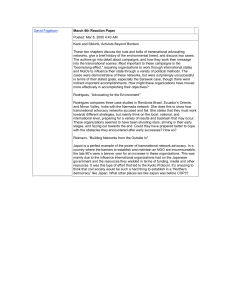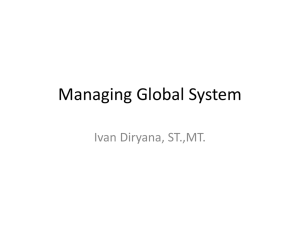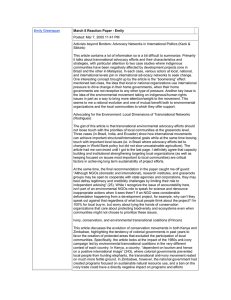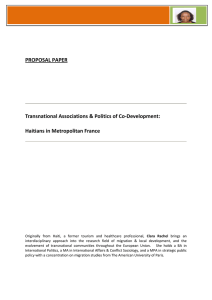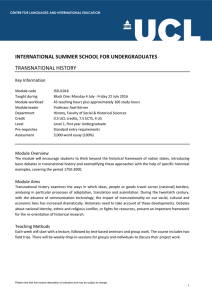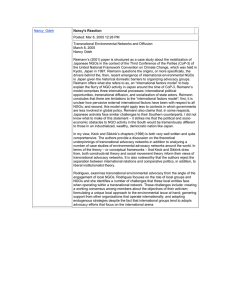Lindsay Campbell 8 March 2005 11.363: Response Paper 4 Keck and Sikkink:
advertisement
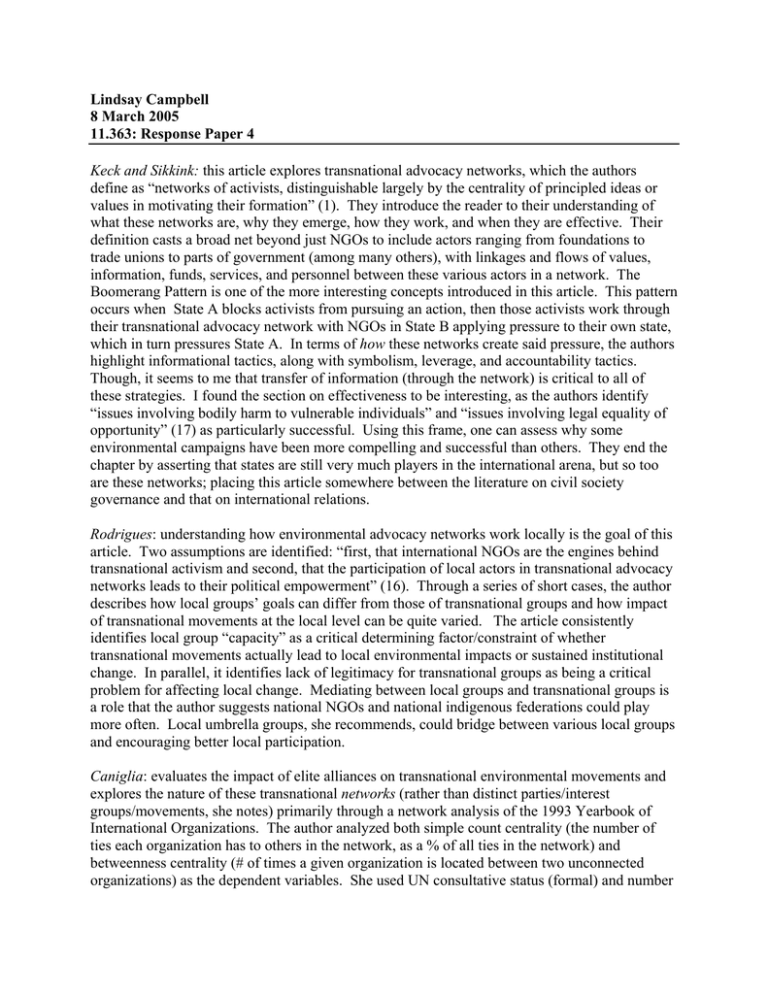
Lindsay Campbell 8 March 2005 11.363: Response Paper 4 Keck and Sikkink: this article explores transnational advocacy networks, which the authors define as “networks of activists, distinguishable largely by the centrality of principled ideas or values in motivating their formation” (1). They introduce the reader to their understanding of what these networks are, why they emerge, how they work, and when they are effective. Their definition casts a broad net beyond just NGOs to include actors ranging from foundations to trade unions to parts of government (among many others), with linkages and flows of values, information, funds, services, and personnel between these various actors in a network. The Boomerang Pattern is one of the more interesting concepts introduced in this article. This pattern occurs when State A blocks activists from pursuing an action, then those activists work through their transnational advocacy network with NGOs in State B applying pressure to their own state, which in turn pressures State A. In terms of how these networks create said pressure, the authors highlight informational tactics, along with symbolism, leverage, and accountability tactics. Though, it seems to me that transfer of information (through the network) is critical to all of these strategies. I found the section on effectiveness to be interesting, as the authors identify “issues involving bodily harm to vulnerable individuals” and “issues involving legal equality of opportunity” (17) as particularly successful. Using this frame, one can assess why some environmental campaigns have been more compelling and successful than others. They end the chapter by asserting that states are still very much players in the international arena, but so too are these networks; placing this article somewhere between the literature on civil society governance and that on international relations. Rodrigues: understanding how environmental advocacy networks work locally is the goal of this article. Two assumptions are identified: “first, that international NGOs are the engines behind transnational activism and second, that the participation of local actors in transnational advocacy networks leads to their political empowerment” (16). Through a series of short cases, the author describes how local groups’ goals can differ from those of transnational groups and how impact of transnational movements at the local level can be quite varied. The article consistently identifies local group “capacity” as a critical determining factor/constraint of whether transnational movements actually lead to local environmental impacts or sustained institutional change. In parallel, it identifies lack of legitimacy for transnational groups as being a critical problem for affecting local change. Mediating between local groups and transnational groups is a role that the author suggests national NGOs and national indigenous federations could play more often. Local umbrella groups, she recommends, could bridge between various local groups and encouraging better local participation. Caniglia: evaluates the impact of elite alliances on transnational environmental movements and explores the nature of these transnational networks (rather than distinct parties/interest groups/movements, she notes) primarily through a network analysis of the 1993 Yearbook of International Organizations. The author analyzed both simple count centrality (the number of ties each organization has to others in the network, as a % of all ties in the network) and betweenness centrality (# of times a given organization is located between two unconnected organizations) as the dependent variables. She used UN consultative status (formal) and number of connections with UN agencies (informal) as two measures of elite alliances. Finally, she controlled for age of the org, NGO membership, size, and headquarters location. The only statistically significant relationship she found was between informal ties and simple count centrality, with little variance explained by formal consultative status. The author attributed this finding to the fact that strict criteria were applied to consultative status, thereby excluding most TSMOs and leading them to pursue alternative strategies through informal ties. She supplemented her statistical analysis with organizational interviews, with similar findings: consultative status/forming informal ties are distinct organizational strategies. She concludes that movement groups can gain advantage by using political networking as a tactic, though not all movements engage in this activity.

